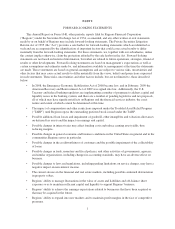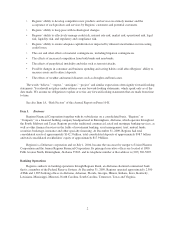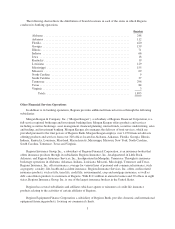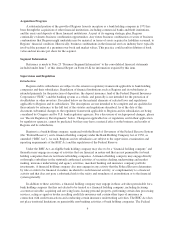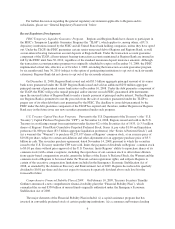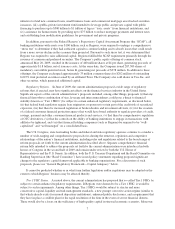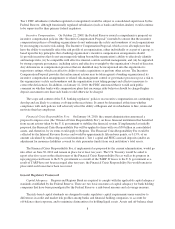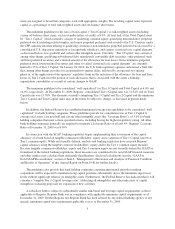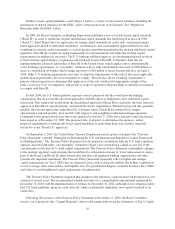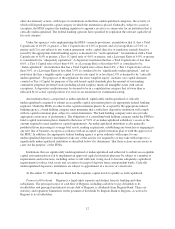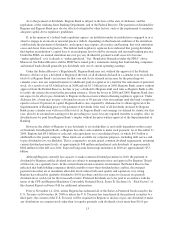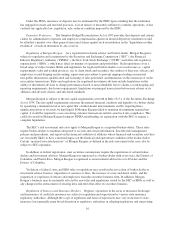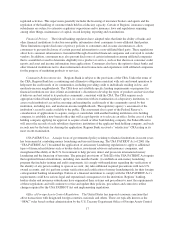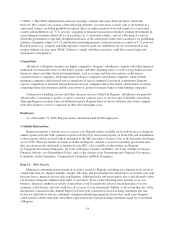Regions Bank 2009 Annual Report Download - page 24
Download and view the complete annual report
Please find page 24 of the 2009 Regions Bank annual report below. You can navigate through the pages in the report by either clicking on the pages listed below, or by using the keyword search tool below to find specific information within the annual report.Failure to meet capital guidelines could subject a bank to a variety of enforcement remedies, including the
termination of deposit insurance by the FDIC, and to certain restrictions on its business. See “Regulatory
Remedies under the FDIA” below.
In 2004, the Basel Committee on Banking Supervision published a new set of risk-based capital standards
(“Basel II”) in order to update the original international capital standards that had been put in place in 1988
(“Basel I”). Basel II provides two approaches for setting capital standards for credit risk—an internal ratings-
based approach tailored to individual institutions’ circumstances and a standardized approach that bases risk-
weighting on external credit assessments to a much greater extent than permitted in the existing risk-based capital
guidelines. Basel II also would set capital requirements for operational risk and refine the existing capital
requirements for market risk exposures. The U.S. banking and thrift agencies are developing proposed revisions
to their existing capital adequacy regulations and standards based on Basel II. A definitive final rule for
implementing the advanced approaches of Basel II in the United States, which applies only to internationally
active banking organizations, or “core banks” (defined as those with consolidated total assets of $250 billion or
more or consolidated on-balance sheet foreign exposures of $10 billion or more) became effective on April 1,
2008. Other U.S. banking organizations may elect to adopt the requirements of this rule (if they meet applicable
qualification requirements), but are not required to comply. The rule also allows a banking organization’s
primary federal supervisor to determine that application of the rule would not be appropriate in light of the
bank’s asset size, level of complexity, risk profile or scope of operations. Regions Bank is currently not required
to comply with Basel II.
In July 2008,the U.S. bank regulatory agencies issued a proposed rule that would provide banking
organizations that do not use the advanced approaches with the option to implement a new risk-based capital
framework. This framework would adopt the standardized approach of Basel II for credit risk, the basic indicator
approach of Basel II for operational risk, and related disclosure requirements. While this proposed rule generally
parallels the relevant approaches under Basel II, it diverges where United States markets have unique
characteristics and risk profiles, most notably with respect to risk weighting residential mortgage exposures.
Comments on the proposed rule were due to the agencies by October 27, 2008, but a definitive final rule had not
been issued as of December 31, 2009. The proposed rule, if adopted, would replace the agencies’ earlier
proposed amendments to existing risk-based capital guidelines to make them more risk sensitive (formerly
referred to as the “Basel I-A” approach).
On September 3, 2009, the United States Treasury Department issued a policy statement (the “Treasury
Policy Statement”) entitled “Principles for Reforming the U.S. and International Regulatory Capital Framework
for Banking Firms.” The Treasury Policy Statement was developed in consultation with the U.S. bank regulatory
agencies and sets forth eight “core principles” intended to shape a new international capital accord. Six of the
core principles relate directly to bank capital requirements. The Treasury Policy Statement contemplates changes
to the existing regulatory capital regime that would involve substantial revisions to, if not replacement of, major
parts of the Basel I and Basel II capital frameworks and affect all regulated banking organizations and other
systemically important institutions. The Treasury Policy Statement repeatedly calls for higher and stronger
capital requirements for Tier 1 FHCs that are deemed to pose a risk to financial stability due to their combination
of size, leverage, interconnectedness and liquidity risk. It is possible that Regions would be deemed a Tier 1 FHC
and subject to such heightened capital requirements if implemented.
The Treasury Policy Statement suggested that changes to the regulatory capital framework be phased in over
a period of several years. The recommended schedule provides for a comprehensive international agreement by
December 31, 2010, with the implementation of reforms by December 31, 2012, although it does remain possible
that U.S. bank regulatory agencies could officially adopt, or informally implement, new capital standards at an
earlier date.
Following the issuance of the Treasury Policy Statement on December 17, 2009, the Basel Committee
issued a set of proposals (the “Capital Proposals”) that would significantly revise the definitions of Tier 1 Capital
10



